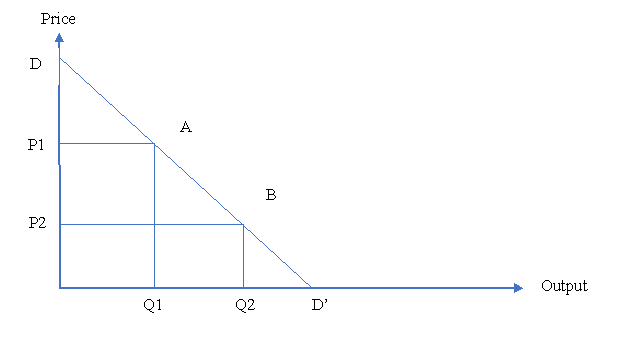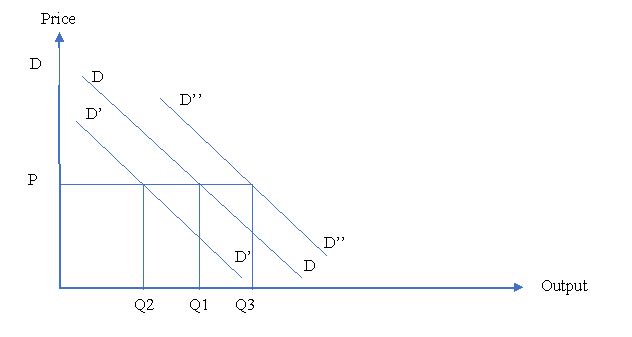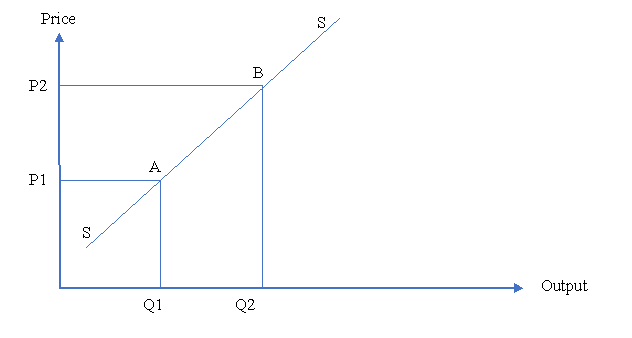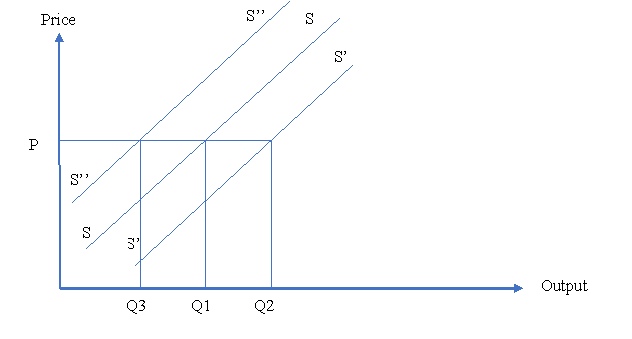Business Economics Assignment Analysing Law of Demand & Supply
Question
Task:
Business Economics Assignment Task
TASK 1 – (1500 words)
Demand and Supply analysis are fundamental to any business thus every business must understand its impact and dynamics. Demand and Supply analysis therefore underlines to some extent the growth and success of most businesses in our society today.
Critically analysed the following micro economics concepts with reference to any business of your choice.
1.1 Explain the law of Demand, movement along the same demand curve (with the aid of diagram) and changes in demand curve (with the aid of diagram).
1.2 Explain the law of Supply, movement along the same supply curve (with the aid of diagram) and changes in supply curve (with the aid of diagram).
TASK 2 – (1000 words) Compare and contrast emerging theories and models in 21st century contemporary economics with those of the 20th century, and relate both of these to modern business practices.
Answer
Business Economics AssignmentTask 1:
Q1.1 Law of demand:
Demand is one of the most fundamental concepts of the economic, where the quantity demand of a goods or service of consumer at different price point is measured. In economies demands means the amount of good and services that a consumer is willing to purchase with available money (Salerno 2020). In contrast to the accounting calculation of the demand, economic demand considers only the amount that a consumer can actually purchase within his budget. Thus, in economics, all demand is effective demand and the cost buyer pays to purchase a product is price.
Demand curve is a line that connects all the demand points of goods and services that a consumer can purchase with all this available budget. As per the law of demand there is a negative relationship between the price and quantity demanded as higher the price lower the demand is. Due to this negative relationship, demand schedule is negatively sloped, where with each unit of rise in price, there is a fall in demand (Vallejo 2021).

Figure 1: Demand schedule
Source: (Created by Author)
Considering the figure 1, here, in the x axis, output has been represented and in the y axis price of the goods and services has been presented. From the figure t can be seen that DD’ is a demand schedule that represents the relation between the price and output. According to law of interest, with different variables (different determinants) staying consistent an ascent or fall in value achieves a fall or ascend demand. Subsequently, when the value rises, the interest falls as well as the other way around, which is displayed in the outline (Mzureket al. 2019). The descending slanting interest bend addresses the opposite connection among cost and request. This is known as a variation in demand, addressed by a development on the demand curve. For instance, if the figure 1 is considered, then it can be seen that if the initial cost is P1, then the demand will be Q1 at point A. It will shift along the same demand curve DD’, with fall in price to P2, where new demand will be Q2 at point B. This way, demand remains at the same position if the price changes and there is no change in other factors (Dean et al. 2020).
However, there are various factors like change in taste, consumer behaviour, change in price of complementary or substitute product can lead to shift in demand curve. As per Zainal et al. (2019), other than value, there are numerous different determinants of interest other than cost like pay of the shopper, cost of related merchandise, taste, propensities and inclinations of the customers, and so on that leads to change in the demand schedule. Although, it is important to keep in mind that, if the price remain unaltered, then the consumer shifts from one demand curve to another with change in the various factors mentioned above that can alter the demand curve (Vallejo 2021). If the price only change keeping other factors unaltered, then the consumer will prefer to remain on the same demand curve moving along with it as can be seen from figure 1. However, if the price change and the factors mentioned above also changes, then the change will depend upon the relative force; if the change in price influence the demand more, then consumer will remain with same demand curve, however, there will be change in quantity demanded. If the relative elasticity of the change in other factors is high, then consumer will shift to new demand curve (Salerno 2020).

Figure 2: Shift in demand schedule
Source: (Created by Author)
Now considering the case of Apple mobile, if there is no change in the price and there is change in other factors like change in consumer behaviour, taste, technology, income or even price of substitute brand, then it will lead to shift in demand curve. If the change in other factors has caused fall in demand for Apple mobiles, then the demand curve will shift leftward to new demand curve D’D’ as per figure 2 due to substitution effect. This will cause fall in output to Q2 and price will remain at P. However, if the change in other factor has caused increase in demand for Apple phones, then the demand curve will shift to the rightward to D’’D”. This will result in rise in output to Q3.
If the short run impact is considered, then with the change in the demand curve, there is no change in the price, however, in successive period, there will be change in the price causing change in the demand and lead it to move back to market equilibrium situation where demand and supply equates (Dean et al. 2020).
Q2.2 Law of supply:
Low of supply is another important fundamental concept of economics that explains the relationship between the supply of goods and services with price. As per the law of supply, if the price of the goods or services increase, then the producers make more product increasing the supply of the same in market; however, if there is fall in price, then the supply become reduced (Zainal et al. 2019). Thus, as per the law of supply, there is a positive association between the supply and price. Hence law of supply is a positively sloped straight line that represent all possible supply position with the given price.

Figure 3: Supply schedule
Source: (Created by Author)
As per the figure 3, in the x axis, output has been represented and in the y axis price of the goods and services has been presented.Supply schedule SS can be seen asan upward sloping straight line as output increase with rise in price (Fukase and Martin 2020). Following the figure 3, if it is assumed that initial market equilibrium supply is at A point where the price is P1 and output is Q1; then with rise in price leads to rise in output with shifting of equilibrium output to B. At point B, output is Q2 and price is P2 and increased price leads to rise in output.
Situation presented in figure 3 is true is there is only change in price and no change in the other factors is there (Takemura 2020). However, apart from price, supply is mainly influenced by the alternative factors like seller number, technology, raw material price, cost expectation of seller and others.
It is important to keep in mind that, if the price remain unaltered, then the producer shifts from one supply curve to another with change in the various factors mentioned above that can alter the supply curve (Kiselevaet al. 2021). If the price only change keeping other factors unaltered, then the producer will prefer to remain on the same supply curve moving along with it as can be seen from figure 3. However, if the price change and the factors mentioned above also changes, then the change will depend upon the relative force; if the change in price influence the supply more, then producer will remain with same supply curve, however, there will be change in quantity supplied (Kiselevaet al. 2021). If the relative elasticity of the change in other factors is high, then producer will shift to new supply curve.

Figure 4: Change in supply schedule
Source: (Created by Author)
Considering the case of the Apple mobile, as per the figure 4, it can be seen that if the price remains unaltered at P, then output of mobiles will be initially at supply curve SS with output Q1. If there is fall in number of retailers, or fall in price of raw materials, increase in technology, or rise in seller’s expectation, then it will lead to rise in supply to S’S’ curve (Davies 2019). At new supply, output of the Apple mobile supply in the market will be Q2 at price P. However, with fall in the suppliers, expectation of seller, technology and rise in price of raw material will lead to fall in supply and shifting the supply curve to S’’S’’. At reduced supply with price P, output will become Q3. Hence, keeping price unaltered and change in other factors than price can lead to shift in supply curve (Sun and Lin 2019). Although it is important to mention that if the short run impact is considered, then with the change in the supply curve, there is no change in the price; or in other terms, price does not lead to any change in supply curve. However, in successive period, there will be change in the price causing change in the supply and lead it to move back to market equilibrium situation where demand and supply equates (Takemura 2020).
Task 2:
Introduction:
Economics is a vast section of study and it matters a lot in present business scenario. Without study of economies, business world would not be able to survive the various shocks and there would have been no development in international trade and business. Apart from this, study of economics has also envisaged the idea of international factor mobility, free trade, international investment that shapes the present business scenario. Over the years, there has been rapid development in the economic theories that explain the present business world. Though the idea of the theories of the business analysis is rooted back in 19th and 20th century, yet their importance is still strong (Fjeldstad and Snow 2018). Present section of the study has done a comparison and contrast to the contemporary economic theories of 20th century with 21st century.
Analysis:
Economic ideas of today are mainly influenced by the ideas developed back in the 19th and 20th century. Though the idea of economics was produced long time ago, however, it came into mainstream analysis, when Adam Smith published his Wealth of Nation. Since then, different economic theories have evolved, different schools of thought have been introduced to explain the economics of the state and trade theories. Moreover, Underpinning the challenges in the present business world, previously available theories are tried to be modified accordingly as there is very limited scope to produce new theory that explain modern trade (Sarasini and Linder 2018). For instance, Adam Smith produced idea to explain trade with absolute advantage theory, which in present time has turned into business cycle theory that considers the market cycles to explain the trade situation. Apart from this, over the period idea of various trading theories has developed by Keynes and other scholar who tried to binning the labour market, commodity market and money market so as to explain the market ups and down with the aggregate demand, supply model, utility curves and other theories. Though these theories rooted back in 19th and 20th century, yet they can explain the situation of 21st century.
Considering the contemporary theories of 20th century with 21st century, following differences can be highlighted:
• Change in approach of economic theories:
Precisely 70 years prior in April 1947, a goal-oriented band of financial specialists made a neoliberal story of the economy and, since Thatcher and Reagan came to drive during the 1980s, it has ruled the worldwide stage (Grayet al. 2018). Its story about the productivity of the market, the inadequacy of the express, the home life of the family and the awfulness of the lodge, has assisted with pushing numerous social orders towards social and biological breakdown. It's an ideal opportunity to compose another monetary story fit during the current century; one that sees the economy's reliance upon society and the living scene. 21st century theories have become more liberal and inclined toward social approach to enhance the social bonding and development through inclusion of diversity in contrast with capitalist nature theory of 20th century(Sharmeenet al. 2020).
• Focus on greener economy:
Over the year, economist focused on greener policies and theories to make the business cycle sustainable. With the regenerative theories and social beneficial models, economists in 20th century came up with policies to make the supply chain and production line sustainable and in 21st century they still hold its importance. Apart from this, there has been good growth of the modern green economic theories which has been developed back in 20th century; for instance, Bretton Woods of 1944 and Rio summit of 1992 was the launching stage of modern green economic ideas on which different economies are expanding sustainable policies (Grayet al. 2018).
Finding:
Primary aim of the present business scenario is to maximise profit or maximise revenue through enhancing the business endeavour. Thus, businesses not only rely on the domestic market, additionally they consider international expansion for better market and higher demand. One major theory that explain the present business scenario is aggregate demand and supply model, which was developed back in 20th century; however, its important is still same. On the other hand, its ha also been found that models like absolute or comparative advantage have become obsolete now, as the business now can be explained with the business cycle model or more advanced real business cycle model (Sarasini and Linder 2018). Apart from this growth model, labour market, and commodity market model of 20th century is still in use, however, they have been modified considering the present market shocks. Idea of growth has certainly changed from GDP to diversified growth approach, apart from this motion model has been came out of scenario in 21st century. Thus, to conclude it can be mentioned that theories of 20th century still hold their importance, however, they have been modified in 21st century to comply with the present market scenario (Davies 2019). Moreover, there has been certain changes in idea of growth, velocity model as well as international trade model that shapes the business world.
Reference:
Davies, R.E., (2019). Laws of Demand and Supply.http://www.greenbag.org/v22n2/v22n2_ex_post_davies.pdf
Dean, E., Elardo, J., Green, M., Wilson, B. and Berger, S., 2020. Demand, Supply, and Equilibrium in Markets for Goods and Services. Principles of Economics: Scarcity and Social Provisioning (2nd Ed.). https://openoregon.pressbooks.pub/socialprovisioning2/chapter/4-1-demand-supply-and-equilibrium-in-markets-for-goods-and-services/
Fjeldstad, Ø.D. and Snow, C.C., (2018). Business models and organization design. Long range planning, 51(1), pp.32-39.https://biopen.bi.no/bi-xmlui/bitstream/handle/11250/2485305/Business%20models%20and%20organization%20design%202018.pdf?sequence=4&isAllowed=y
Fukase, E. and Martin, W., (2020).Economic growth, convergence, and world food demand and supply. World Development, 132, p.104954. https://www.sciencedirect.com/science/article/pii/S0305750X20300802
Gray, J., O’Regan, J.P. and Wallace, C., (2018). Education and the discourse of global neoliberalism. Language and Intercultural Communication, 18(5), pp.471-477.https://www.tandfonline.com/doi/pdf/10.1080/14708477.2018.1501842
Kiseleva, I.A., Kuznetsov, V.I., Sadovnikova, N.A. and Androshina, I.S., (2021). Simulations of Supply and Demand Forecasting in A Market Economy. REVISTA GEINTEC-GESTAO INOVACAO E TECNOLOGIAS, 11(4), pp.1669-1684.https://revistageintec.net/index.php/revista/article/download/2218/1538
Mazurek, J., García, C.F. and Rico, C.P., (2019). The law of demand and the loss of confidence effect: An experimental study. Heliyon, 5(11), p.e02685.https://www.sciencedirect.com/science/article/pii/S2405844019363455 Salerno, J., (2020). The Wealth Effect and the Law of Demand: A Comment on Karl-Friedrich Israel. Quarterly Journal of Austrian Economics, 22(4), pp.579-595.https://qjae.scholasticahq.com/article/12282.pdf
Sarasini, S. and Linder, M., (2018).Integrating a business model perspective into transition theory: The example of new mobility services. Environmental innovation and societal transitions, 27, pp.16-31.https://www.researchgate.net/profile/Steven-Sarasini/publication/320365553_Integrating_a_business_model_perspective_into_transition_theory_The_ example_of_new_mobility_services/links/5d4348854585153e5935346b/Integrating-a-business-model- perspective-into-transition-theory-The-example-of-new-mobility-services.pdf
Sharmeen, F., Drost, D. and Meurs, H., (2020). A business model perspective to understand intra-firm transitions: From traditional to flexible public transport services. Business economics assignmentResearch in Transportation Economics, 83, p.100959.https://www.ncbi.nlm.nih.gov/pmc/articles/pmc7487080/
Sun, Y.Y. and Lin, P.C., (2019). How far will we travel? A global distance pattern of international travel from both demand and supply perspectives. Tourism Economics, 25(8), pp.1200-1223.https://journals.sagepub.com/doi/pdf/10.1177/1354816618825216
Takemura, R., (2020). Economic reasoning with demand and supply graphs. Mathematical Social Sciences, 103, pp.25-35.https://abelard.flet.keio.ac.jp/person/takemura/paper/42-el-ecograph.pdf
Vallejo, H., (2021). A Theorem of the Law of Demand.https://repositorio.uniandes.edu.co/bitstream/handle/1992/50543/dcede2021-33.pdf Zainal, R., Ramli, F., Manap, N., Ali, M., Kasim, N., Noh, H.M. and Musa, S.M.S., (2019).Price prediction model of demand and supply in the housing market.In MATEC Web of Conferences (Vol. 266, p. 06015).EDP Sciences.https://www.matec-conferences.org/articles/matecconf/pdf/2019/15/matecconf_iconbee2019_06015.pdf












